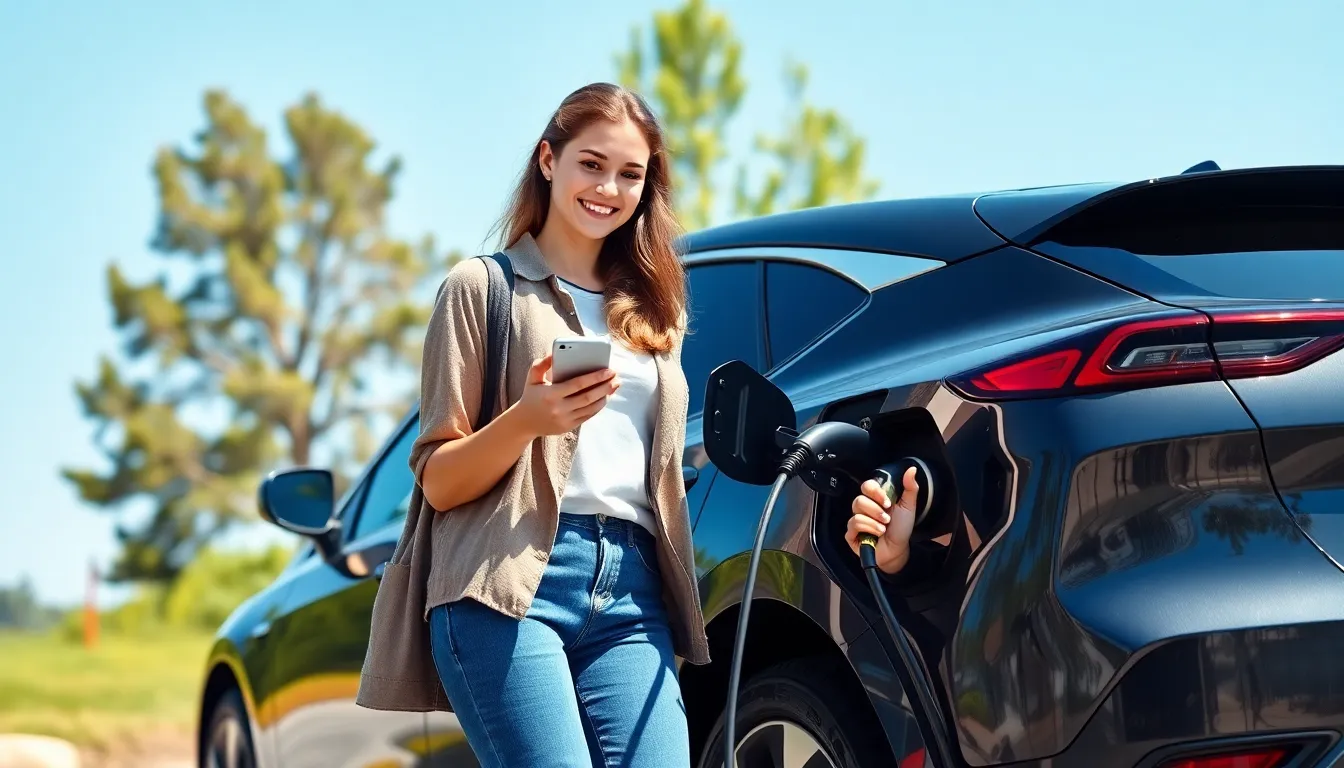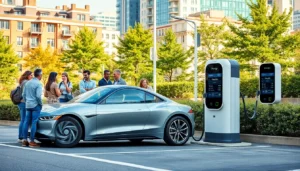When the skies open up and rain starts to pour, many drivers might wonder if their electric car can handle the wet stuff. After all, water and electricity don’t typically mix well, right? But fear not! Electric vehicles are engineered to brave the elements, including those unexpected downpours.
Table of Contents
ToggleOverview of Electric Car Performance
Electric cars demonstrate reliable performance in rainy conditions. Engineers design these vehicles with waterproof components that protect electrical systems from moisture damage. Battery packs feature sealed enclosures, which prevent water intrusion.
In addition, traction control systems enhance grip on slippery surfaces. Electric motors provide instant torque, allowing for quick acceleration without slipping. Regenerative braking also aids in maintaining traction during wet weather, helping to avoid skids.
Many electric vehicles utilize all-wheel drive systems, improving stability on wet roads. These systems distribute power to all four wheels, enhancing control during rain and reducing the risk of hydroplaning. Several models come equipped with advanced tires that improve wet traction, adding another layer of safety.
Rain sensors in some electric cars adjust wiper speeds according to rainfall intensity. This feature enhances visibility, enabling drivers to maintain focus on the road. Additionally, many manufacturers include stability control systems that mitigate oversteer, ensuring a safer driving experience.
Electric cars also come with updated technologies, like adaptive cruise control. This technology maintains safe distances from vehicles ahead, adjusting speed during wet conditions to prevent accidents. Overall, electric cars offer excellent performance in rain, backed by advanced engineering and safety features.
Key Factors Affecting Performance in Rain
Electric cars exhibit strong performance in rainy conditions due to several critical factors. Understanding how these elements work can enhance driver confidence.
Traction and Tire Performance
Optimal tire performance plays a significant role in maintaining traction on wet roads. Tires on electric vehicles often feature advanced tread designs that channel water away, reducing the risk of hydroplaning. All-season tires commonly equipped on many models provide adequate grip in various weather conditions. Additionally, the instant torque from electric motors aids in smooth acceleration, minimizing wheel spin on slippery surfaces. Most electric cars come with traction control systems that further enhance grip, allowing for stable handling in wet weather.
Weight Distribution and Stability
Effective weight distribution contributes to enhanced stability when driving in rain. Many electric vehicles have low centers of gravity from battery placement in the chassis, which helps reduce rollover risks. This design not only improves handling but also maintains traction during sharp turns. Vehicles with all-wheel drive systems often provide better stability by distributing power to all wheels, improving grip. Drivers can feel more secure knowing that advanced stability control systems work to counteract skidding, allowing safe navigation through challenging wet conditions.
Battery Efficiency in Wet Conditions
Battery efficiency in wet conditions depends on several key factors. Waterproof components play a crucial role in protecting electric vehicles from moisture. Sealed battery packs ensure that water doesn’t enter and compromise electrical systems. Enhanced insulation helps maintain optimal battery performance, even in rainy weather.
Charging speeds can fluctuate with wet conditions. Charging systems adjust to maintain efficiency, preventing the battery from overheating. Drivers might notice minor delays during charging, but overall efficiency remains intact. Electric vehicles incorporate thermal management systems to regulate temperature, ensuring effective operation despite external weather impacts.
The cooling systems also maintain battery longevity in variable climates. Proper temperature control allows the battery to function optimally. Drivers benefit from improved battery life and efficiency throughout different weather conditions. With proper design, electric vehicles demonstrate resilience against the challenges posed by rain.
Electric motors contribute to performance despite wet conditions. Instant torque provides smooth, responsive acceleration, reducing the likelihood of wheel spin. This aspect enhances control when navigating slippery surfaces. Advanced traction control systems further improve grip on wet roads, fostering a sense of stability.
Drivers can feel confident navigating through rain. Proper tire maintenance, including checking tread depth, enhances traction and promotes overall safety. Advanced tire designs provide effective water dispersion, reducing hydroplaning risks. Electric vehicle manufacturers prioritize performance, ensuring that batteries maintain efficiency and safety in challenging weather situations.
Safety Features in Electric Cars
Electric cars are equipped with numerous safety features designed to enhance performance in rainy conditions. Waterproof components protect critical electrical systems from moisture, ensuring reliability. Sealed battery packs prevent water intrusion, maintaining the integrity of the vehicle’s power supply.
Traction control systems play a vital role in improving grip on slippery surfaces. These systems adjust the power delivered to the wheels, minimizing slippage during acceleration. Advanced tire designs also contribute to safety; many tires channel water away effectively, reducing hydroplaning risks.
All-wheel drive systems further enhance stability by distributing power to all four wheels. With power sent to both the front and rear wheels, drivers enjoy improved handling in wet weather. Stability control systems also mitigate oversteer, allowing for confident maneuvering on slick roads.
Rain sensors represent another innovative feature in many electric vehicles. These sensors automatically adjust wiper speeds based on precipitation intensity, ensuring drivers maintain clear visibility. Adaptive cruise control systems help manage speed, adjusting automatically to maintain safe distances from other vehicles during rainy conditions.
Well-maintained tires provide essential traction and grip. Regularly checking tire pressure and tread depth ensures optimal performance in wet weather. Balance in weight distribution enhances stability further, giving drivers a sense of control during sharp turns.
Incorporating these safety features, electric cars are engineered to handle rain efficiently. Overall, they provide a reassuring driving experience, equipped with technology designed specifically to counteract the challenges posed by wet weather conditions.
Real-World User Experiences
Drivers often report positive experiences with electric cars in rainy conditions. Many users appreciate the instant torque offered by electric motors, enabling smooth acceleration even on slick roads. Enhanced traction control systems typically minimize slippage, allowing for confident driving when it rains.
All-wheel drive systems frequently receive praise for improving stability, particularly when navigating through puddles or wet turns. While driving through downpours, some drivers note that advanced tire designs effectively channel water away, significantly reducing hydroplaning risks.
Smooth handling becomes evident during sharp turns, as the low center of gravity from battery placement contributes to vehicle stability. Additionally, the seamless integration of rain sensors ensures optimal visibility by automatically adjusting wiper speeds according to precipitation intensity.
Users also commend the efficiency of thermal management systems, which help maintain battery performance in wet conditions. Fluctuations in charging speeds can occur during rain, but these systems regulate temperature effectively, preventing overheating.
Regular tire maintenance emerges as crucial for maximizing grip, ensuring safe navigation through challenging wet weather. Overall, the combination of innovative technology and thoughtful engineering allows electric vehicles to perform well in rain, meeting the expectations of many users.
Conclusion
Electric cars are well-equipped to handle rainy conditions, ensuring a safe and reliable driving experience. Their advanced engineering features, including waterproof components and effective traction control systems, enhance performance in wet weather. With instant torque and all-wheel drive capabilities, these vehicles provide excellent grip and stability on slippery surfaces.
Drivers can trust that electric cars maintain optimal battery efficiency even in rain, thanks to robust thermal management systems. The positive feedback from users further reinforces the notion that electric vehicles excel in challenging weather. Overall, the combination of innovative technology and thoughtful design makes electric cars a smart choice for navigating rainy roads.










